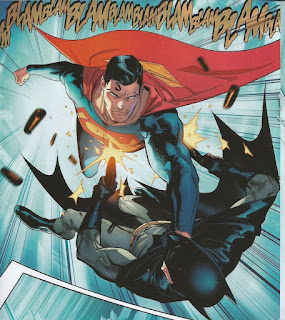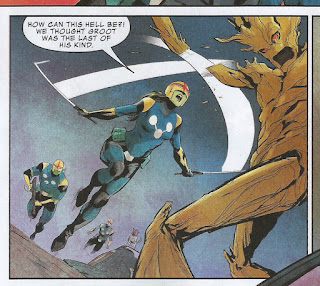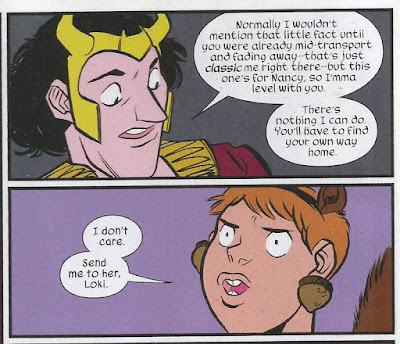Pick of the Brown Bag
December 20, 2017
by
Ray Tate
My Favorite Christmas Song
Happy holidays, from the Pick of the Brown Bag. With the last minute shopping, maybe you didn’t get a chance to check out the weekly reviews. You’re at the comic book shop with no idea if a book is worth purchasing. Not to worry. Glance at the reduced reviews on Twitter: #PickoftheBrownBag. For this last week of December I review, Angel, Batman, Guardians of the Galaxy, Hellboy: Krampusnacht, Marvel Two-In One, The Mighty Thor, Peter Parker: Spider-Man and Superman.
I’ve always felt that the Krampus is in fact a hoax response to Fox News and their annual “War on Christmas” paranoia. I’ve never heard of this sometimes nemesis of Santa Claus until the modern age. None of my texts on folklore once mention the creature. He's absent from Dungeons and Dragons bestiaries. So, I roll my eyes in doubt whenever the legendary beast takes the spotlight.
Is Rankin/Bass to blame?
Hellboy: Krampusnacht is easily the most entertaining treatment of the bugbear I’ve witnessed.
As illustrated by Adam Hughes, the one-shot looks amazing. Hughes' style is the opposite of Hellboy creator Mike Mignola. His work is soft and rounded. Mignola's art, sharp and angled. What they share lies in shadowy horror.
The highly recommended Ghost is an Adam Hughes’ touchstone. So, it’s no real surprise to see such craft in the design of the Krampus, the swathe of inks that seem to follow Hellboy and a spectral presence that serves as a foreboding.
Mignola’s story takes some welcome departures from the Krampus meme that actually make a lot of sense. In terms of biology and supernatural trappings. Mignola furthermore may be employing a very sly gag in the origin of the Krampus. He also may have insightfully pinpointed the zeitgeist origin of the monster. Think of your nursery rhymes.
Angel concludes its "season" with a chatty finale that recapitulates previous chapters in the discussion. That would normally earn it a lump of coal, but writer Corinna Bechko actually makes this dialogue between Angel and Fred/Illyria interesting.
The book isn't completely without action, but the kinetics of the final battle takes a back seat to philosophy and characterization. Artist Geraldo Borges succeeds in presenting the conflict through expressions and the body language of the stars.
The second part of Tom King’s “Super-Friends” unfolds with the Dark Knight, Catwoman, Superman and Lois Lane spending a night at the fair. This issue of Batman like the last is pure comedy, and I shan’t spoil anything. The art by Clay Mann and Jordie Bellaire is also loaded with spoilers.
The only depiction I can reveal without divulging punchlines.
If you like the above graphic, you’ll like the rest of the gorgeous illustration and the imaginative panel layout.
King’s story takes a classic World’s Finest tactic and turns it into a running visual gag that’s also the center for a handful of related jokes. Once this ball is in play, King begins comedic discussion between the couples. King gives you an intimate peek into how a conversation might indeed go between the four. The best friends in question of course seem to blend together like oil and water, but the reason why they are such good pals is that they accept each other for who they are.
Lois and Catwoman hit it off like two normal women, but their dialogue reveals neither really are. The difference is that Lois and Catwoman are strange in comparison to the real world. Batman appears to be odd when compared to everything. He cannot cope easily with social interaction, except when with Catwoman or on a case. King though demonstrates that a few things in Batman’s repertoire are indeed fathomable, and while Batman is terse and more alien than the alien, he's just human enough to warm up a degree.
Dramatic impetus arrives hilariously decked out as an in-character wannabe. The World’s Finest team makes short work out of him through a means that offers the reader more foreshadowing to the finale. The miscreant’s literal downfall is a laugh out loud funny moment as is the self-deprecating humor King instills in his own storytelling. These days, you just cannot go wrong with Batman.
Superman on the other hand is a what the hell just happened kind of story.
So, briefly. Young Tim Drake figured out that Bruce Wayne and Dick Grayson are Batman and Robin by observing Dick’s singular acrobatic trickery. When the Joker murders Jason Todd, the second Robin, Tim Drake notices how brutal Batman becomes.
Batman needs a Robin, and after some villain murders Tim’s family, Robin needs Batman. The new 52 compresses these multi-year stories into a very tight span including Jason’s resurrection in a Lazarus Pit.
I bring this information up for a reason. Bruce isn’t fighting himself in dream or reality. That’s apparently an adult Tim Drake beneath the cowl, and he is pissed off.
What, no spoiler alert? Yeah, well, this story is all muffed up anyway. How many people wanted to see Batman duke it out with Time Drake? Anybody?
I thought not.
Tim Drake in the present is actually a teen-aged Teen Titan known as Red Robin. Bruce is fighting Tim’s possible future not even the real Tim Drake from the future.
Peter Tomasi invokes the phrase Hypertime to explain Tim’s appearance.
Hypertime was a shit-poor post-Crisis writer’s device designed to deprive Bronze Age fans of a concrete multiverse or unique cosmos that made any sense. Earth-Two could exist but only for a blink of an eye, and in a gazillion different forms. Not one you probably liked.
Hypertime was a shit-poor post-Crisis writer’s device designed to deprive Bronze Age fans of a concrete multiverse or unique cosmos that made any sense. Earth-Two could exist but only for a blink of an eye, and in a gazillion different forms. Not one you probably liked.
Unsurprisingly, none of these possible futures posited Barbara Gordon walking unless she was subsequently crippled or killed at the end of the story. Hypertime fixed nothing and exacerbated the problem with the DCU that the new 52 subsequently repaired.
It was the spine all along.
With the new 52, a concrete multiverse does exist. Earth-Two exists, and Helena Wayne and Power Girl also exist. Thanks to Rebirth, it’s doubtful Batman and Superman remember meeting them, but they still exist.
Now Hypertime returns. A dank cesspool of an idea that only delivers dark probabilities of the future. Fine. The presence of a thriving multiverse undermines the validity of the concept even more, and this story is rubbish. Tim Drake seeks to save his dark future by killing off Superboy. How does that even work? He's not the Tim Drake from Batman's timeline. Ergo, neither is Jonathan Kent.
Anyway, Tim's want naturally pits him against Superman and Batman. First, Drake takes out Batman. Then he revisits Batman’s suitcases of contingency to confront Superman.
Anyway, Tim's want naturally pits him against Superman and Batman. First, Drake takes out Batman. Then he revisits Batman’s suitcases of contingency to confront Superman.
The best thing about this story is that neither Batman or Superman view Tim Drake as the real deal. They treat him as a threat, a phantasm from the future, and they have no interest in preserving his timeline. Let it die.
The second best thing about this story is that Batman informed Superman about what happened to him in Detective Comics, where screwy Tim Drake made his debut. Batman isn’t keeping things from Superman or the Justice League. So, Superman isn’t surprised that some whacko Tim Drake in a Batman costume somehow threatens his family. Just another nutcase that needs put down.
Things continue to heat up in Peter Parker. When real cops under the aegis of fake cops threatened to arrest Aunt May, Peter turned himself. Now, he stews in holding.
Gray Sword, a shady SHIELD offshoot and the cause of all this strife shows up and adds the possibility of illegal disappearing. Peter’s only in danger only up to the point where he wants to protect his secret identity.
Fortunately, Peter has friends and maybe a sister.
The best laid plans of Mintz and men often go awry. Writer Chip Zdarsky gives it to the sleaze-ball SHIELD Agent but good.
This story could have easily gone dark, and the cover promises Black Panther somehow becoming involved in the hunt for Spider-Man. T’Challa shows up, but not in the way you think.
It's so refreshing to not have a superhero slugfest. Black Panther is probably the last super-hero you thought would show up, but here he is. I think he only appeared once with Spidey in Marvel Team-Up.
Marvel Two-In One returns with the star of the previous edition The Thing. Believe it or not you can mess up the Thing. The character writes himself. Nevertheless, a lot of modern writers cannot grasp the simplicity of Ben Grimm.
The Thing is a meat and potatoes hero. He’s tough. He’s terse. He’s fiercely loyal to his friends and family. He likes to hit things. The source of his greatest complexity lies in his piloting skills.
I’m happy to say we don’t get any ambiguity for his return. Chip Zdarsky, again, hits all the right craggy marks.
From Ben’s side of things, the story opens at a gala honoring Reed and Sue’s memory with the creation of the Fantastic Award.
From Ben’s side of things, the story opens at a gala honoring Reed and Sue’s memory with the creation of the Fantastic Award.
Reed and Sue apparently died during Battle World, or whatever it is. We don’t need the details, and artist Jim Cheung and colorist Frank Martin carries out an emotional shorthand.
Spider-Man battling Wrecking Crew member Pile Driver stops by to voice his concern about Johnny. It seems the Torch may have a death wish, but that's not Storm's claim.
Whereas in the original Marvel Two-In-One Ben teamed up with various heroes, this new volume looks to focus on the remaining two Fantastic Four members. It's a perfect match with a perfect title and the perfect writer for characters that are crystalized more so than others. Though I'm sure other artists can render the book, Jim Cheung and company produces excellent artwork that presents the ideal of the heroes with an outer-reaching scope of backdrops and guest stars.
This is easily one of the most optimistic recent issues of the Mighty Thor despite the promise of killing the title character and the ongoing battle against Malekith and his vast alliances with baddies from all the nine realms. The story starts out with guest star Hercules.
The Franklin Mint presents a limited edition plate of...
More comedy occurs when the artist formerly known as Thor shows up to express his jealousy over Hercules' fairer treatment of the fairer sex Thunder Goddess. Hercules' answer to Odinson's question is at once characteristic and risible. Odinson also tries to reason with Jane, who suffering from cancer, continues to miss her chemotherapy.
I'm calling you out, Odin!
Writer Jason Aaron came up with the brilliant idea that upon transforming to Thor, Jane is magically healed. Not of cancer, but of the poisons she ingests to fight the cancer. If we imagine the hammer to be an advanced computer, it analyzes what's not Jane and expels it. Cancer is part of the body. It's unchecked cell growth. The hammer measures the cancer as part of the person.
As the Talons of the Shiar lay out their plans for assault on the Nova Corps, Rocket's scheme for rooting out the crooked Novas fruits.
I have to say that Rocket's plan is genius. It explains everything. Rocket's gung-ho attitude. His lack of interest in ill gotten gain. Everything. Fortunately for me, there's a side B to the disc that allows me to share some of Marcus To's splendid graphics.
The other Guardians of the Galaxy meet up with Russian telepathic dog Cosmo, no idea, to face the growing subplot that's rooted its way through Gerry Duggan's run.






























































